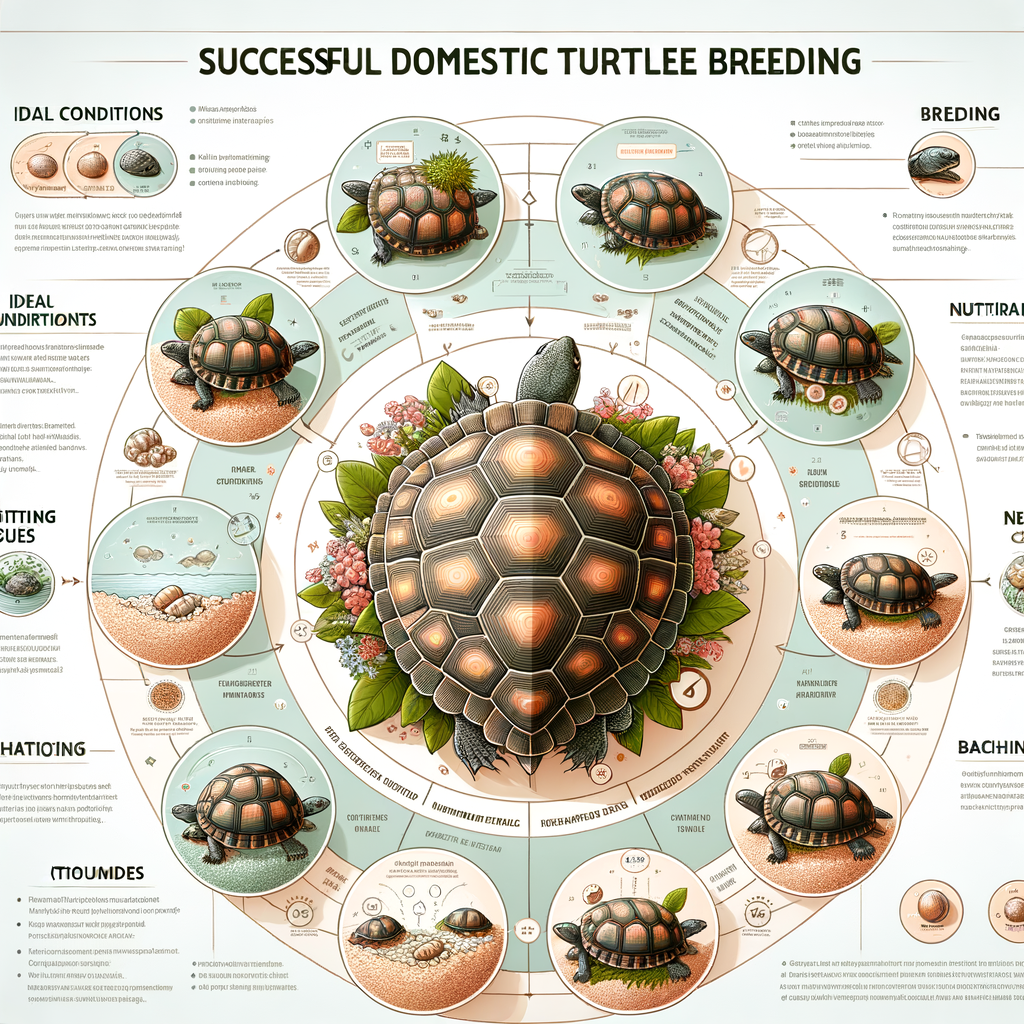
Introduction to Turtle Breeding Guide
Welcome to our comprehensive guide on turtle breeding. This guide is designed to provide you with all the necessary information you need to successfully breed turtles. Whether you are a beginner or an experienced turtle keeper, this guide will be of great help to you.
- Why breed turtles?
- The importance of responsible breeding
Turtles are fascinating creatures with unique characteristics that make them interesting pets. Breeding turtles can be a rewarding experience, both emotionally and financially. Not only do you get to witness the miracle of life, but you also contribute to the preservation of various turtle species. Moreover, breeding turtles can be a profitable venture, as there is a high demand for pet turtles.
While breeding turtles can be rewarding, it’s crucial to understand the importance of responsible breeding. Irresponsible breeding can lead to overpopulation and health issues among turtles. Responsible breeding ensures the health and well-being of the turtles, and it also helps maintain the balance in their population. It’s our duty as turtle keepers to ensure that our breeding practices are ethical and beneficial to the turtles.
In the following sections, we will delve deeper into the basics of understanding turtles, comprehensive turtle breeding techniques, turtle reproduction, and tips and tricks for turtle breeding. We will also discuss turtle breeding care and maintenance, and finally, we will talk about the rewards of turtle breeding.
So, let’s embark on this exciting journey of turtle breeding!
Understanding Turtles: The Basics
Before we delve into the world of turtle breeding, it’s crucial to understand the basics about turtles. This includes their anatomy and physiology, which play a significant role in their breeding process. Let’s explore these aspects in detail.
Turtle Anatomy and Physiology
Turtles are fascinating creatures with unique anatomical and physiological features. Understanding these can help us better care for them and optimize their breeding process.
- Understanding Turtle Anatomy
Turtles have a hard shell, known as the carapace, which protects them from predators. This shell is made up of approximately 60 different bones fused together. Underneath the shell, turtles have a skeletal structure similar to other vertebrates, with a spine, rib cage, and other bones. They also have a beak instead of teeth, and their eyes can see a range of colors.
One unique aspect of turtle anatomy is their internal organs. For instance, turtles have a three-chambered heart, unlike the four-chambered heart found in humans. They also have a cloaca, a single opening for the digestive, urinary, and reproductive systems.
- How Turtle Physiology Affects Breeding
The physiology of a turtle plays a significant role in its breeding process. Turtles are ectothermic, meaning their body temperature is regulated by the external environment. This is important because the temperature can influence the sex of the hatchlings. In many turtle species, higher temperatures result in more female hatchlings, while lower temperatures produce more males.
Furthermore, turtles have a unique reproductive system. Female turtles can store sperm for several years, allowing them to fertilize eggs long after mating. This is a crucial factor in turtle breeding, as it allows for flexibility in the timing of egg-laying.
In conclusion, understanding the anatomy and physiology of turtles is essential for successful turtle breeding. By understanding these aspects, we can provide the best care for our turtles and optimize their breeding process.
Turtle Behavior
Understanding the behavior of turtles is crucial in the world of turtle breeding. Turtles are unique creatures with behaviors that may seem peculiar to us, but are perfectly normal for them. Let’s delve into the common behaviors of turtles and how these behaviors impact successful turtle breeding.
- Common Turtle Behaviors
- How Behavior Impacts Successful Turtle Breeding
Turtles are generally solitary creatures, preferring to spend most of their time alone. They are also known for their slow movements and their ability to retract their heads and limbs into their shells for protection. Turtles are ectothermic, meaning they rely on their environment to regulate their body temperature. This is why you often see turtles basking in the sun. They are also omnivores, eating a diet that includes both plants and small animals.
The behavior of turtles plays a significant role in successful breeding. For instance, male turtles perform a courtship dance to attract females. This includes head bobbing and circling around the female. If the female is receptive, she will allow the male to mount her for mating. After mating, the female will look for a suitable place to lay her eggs, usually in a quiet, sandy area. Understanding these behaviors can help breeders create a conducive environment for turtle breeding.
Recognizing and respecting these behaviors is key to successful turtle breeding. By providing an environment that caters to these behaviors, you are more likely to have a successful breeding experience. Remember, patience is key when dealing with turtles. Their slow pace and unique behaviors are part of what makes them such fascinating creatures.
Comprehensive Turtle Breeding Techniques
When it comes to turtle breeding, the first step is choosing the right turtles. This is a crucial step that can determine the success of your breeding efforts. Let’s delve into the specifics of what to look for in a breeding turtle and common mistakes to avoid.
Choosing Your Breeding Turtles
Choosing the right turtles for breeding is not as simple as it sounds. There are specific characteristics and factors to consider. Let’s take a look at these in detail.
- What to look for in a breeding turtle
- Age: Turtles should be mature enough to breed. This typically means they should be at least 5 years old.
- Health: Healthy turtles are more likely to breed successfully. Look for clear eyes, smooth shells, and active behavior.
- Species: Some turtle species breed more readily than others. Research your chosen species to understand their specific breeding habits.
- Common mistakes in choosing breeding turtles
- Choosing young turtles: Turtles that are too young may not be ready to breed. This can lead to unsuccessful breeding attempts.
- Ignoring health issues: Unhealthy turtles may have difficulty breeding. Always ensure your turtles are in good health before attempting to breed them.
- Not considering species: Not all turtle species breed in the same way. Failing to consider the specific breeding habits of your chosen species can lead to unsuccessful breeding.
When selecting a turtle for breeding, consider the following:
When choosing turtles for breeding, avoid these common mistakes:
By understanding what to look for in a breeding turtle and avoiding common mistakes, you can increase your chances of successful turtle breeding. Remember, patience and knowledge are key in this process.
Creating the Ideal Breeding Environment
When it comes to turtle breeding, creating the perfect environment is crucial. This involves setting up the breeding tank and considering temperature and lighting. Let’s delve into these aspects.
- Setting up the Breeding Tank
- Temperature and Lighting Considerations
The breeding tank is the turtle’s home and should be set up to mimic their natural habitat as closely as possible. A large tank is essential as it provides enough space for the turtles to move around and for the eggs to be laid and hatch. The tank should be filled with clean water, and a dry area should be provided for the turtles to bask and lay eggs. The dry area can be made using large, flat rocks or a ramp leading to a dry platform.
Moreover, the tank should be kept clean to prevent the spread of diseases. Regular water changes and cleaning of the tank are necessary. It’s also important to provide hiding spots for the turtles, such as underwater caves or plants, to help them feel secure.
Temperature and lighting play a significant role in turtle breeding. The water temperature should be kept between 75 and 85 degrees Fahrenheit, while the basking area should be slightly warmer, around 90 degrees Fahrenheit. A water heater and a thermometer can help maintain these temperatures.
Lighting is also crucial as it helps regulate the turtles’ sleep-wake cycle and aids in their digestion. A combination of UVA and UVB lights is recommended. UVA light encourages behaviors such as feeding, basking, and mating, while UVB light helps turtles produce vitamin D3, which is essential for their shell and bone health.
| Aspect | Details |
|---|---|
| Breeding Tank Size | Large |
| Water Temperature | 75-85 degrees Fahrenheit |
| Basking Area Temperature | ~90 degrees Fahrenheit |
| Lighting | UVA and UVB lights |
In conclusion, setting up the ideal breeding environment for turtles involves careful consideration of the tank setup, temperature, and lighting. By mimicking their natural habitat as closely as possible, you can increase the chances of successful turtle breeding.
Guide to Turtle Reproduction
In this section, we will delve into the fascinating world of turtle reproduction. We will explore the breeding process, which includes how turtles mate and the signs of successful mating.
The Breeding Process
Understanding the breeding process of turtles is essential for anyone interested in turtle breeding. Let’s take a closer look at the two main steps involved in this process.
- How turtles mate: Turtles mate in water, with the male mounting the female from behind. The male turtle uses his long claws to hold onto the female’s shell during the process. This can take anywhere from a few minutes to several hours. It’s important to note that turtles do not mate for life and can have multiple partners.
- Signs of successful mating: After mating, the female turtle will start looking for a suitable place to lay her eggs. This is usually a sandy area where she can easily dig a nest. If you notice your female turtle showing signs of restlessness, digging, or increased appetite, these could be signs of successful mating. Additionally, you might notice a change in her shell’s shape as the eggs develop inside her.
Now that we’ve covered the basics of the turtle breeding process, you should have a better understanding of how turtles reproduce. In the next section, we will discuss what happens after mating, including how to care for turtle eggs and what to expect during the incubation period.
After Mating: The Incubation Period
Once the mating process is complete, the next crucial stage in turtle reproduction is the incubation period. This period is vital for the development of the turtle eggs and requires careful attention and care.
- How to Care for Turtle Eggs
- Temperature: Maintain the temperature of the incubation area between 80-85 degrees Fahrenheit. The temperature can influence the sex of the hatchlings.
- Humidity: Keep the humidity level around 70-80%. Too much or too little humidity can harm the eggs.
- Handling: Avoid handling the eggs as much as possible. If you need to move them, be gentle and do not rotate them.
- What to Expect During the Incubation Period
- Duration: The incubation period typically lasts between 45-90 days, depending on the species and environmental conditions.
- Signs of Development: You may notice changes in the color and texture of the eggs. This is a positive sign of development.
- Hatching: When the time comes, the hatchlings will break through the shell using a special tooth called a ‘caruncle’. Don’t rush this process – it’s important for the hatchlings to do it themselves.
Turtle eggs are delicate and require a specific environment to thrive. Here are some key points to consider:
The incubation period is a time of anticipation and patience. Here’s what you can expect:
| Aspect | Details |
|---|---|
| Temperature | 80-85 degrees Fahrenheit |
| Humidity | 70-80% |
| Handling | Minimal and gentle |
| Incubation Duration | 45-90 days |
| Signs of Development | Change in color and texture |
| Hatching | Self-initiated by hatchlings |
Remember, every turtle species is unique, and these guidelines may vary. Always research and understand the specific needs of your turtle species to provide the best care possible.
Turtle Breeding Tips and Tricks
When it comes to breeding turtles, there are several tips and tricks that can help maximize your success. In this section, we will discuss key strategies and common problems to avoid.
Maximizing Breeding Success
Successful turtle breeding requires a combination of the right environment, proper care, and a good understanding of turtle behavior. Here are some tips to help you achieve breeding success:
- Understanding Turtle Behavior: Turtles have unique behaviors during the breeding season. Males may become more aggressive, while females may start looking for nesting sites. Understanding these behaviors can help you provide the right environment for breeding.
- Creating the Right Environment: Turtles need a specific environment for breeding. This includes a large enough enclosure, the right temperature, and proper lighting. Research your specific breed of turtle to understand their needs.
- Proper Nutrition: A healthy diet is crucial for successful breeding. Turtles need a balanced diet of fruits, vegetables, and proteins to ensure they are in the best health for breeding.
While these tips can increase your chances of successful breeding, there are also common problems that can hinder your efforts. Let’s take a look at these issues and how to avoid them.
- Incorrect Temperature: Turtles are very sensitive to temperature. If the temperature in the enclosure is too high or too low, it can affect their ability to breed. Make sure to monitor the temperature regularly and adjust it as needed.
- Poor Nutrition: As mentioned earlier, nutrition plays a key role in turtle breeding. If turtles are not getting the nutrients they need, it can affect their health and their ability to breed. Make sure to provide a balanced diet and consider adding supplements if necessary.
- Stress: Turtles can become stressed if their environment is not suitable or if they are not handled properly. This can lead to health problems and can affect their ability to breed. Make sure to handle your turtles gently and provide a calm and quiet environment.
By following these tips and avoiding common problems, you can maximize your chances of successful turtle breeding. Remember, patience is key. Breeding turtles can take time, but the rewards are well worth the effort.
Breeding Turtles at Home
Many turtle enthusiasts find joy in breeding turtles at home. It can be a rewarding experience, but it also requires careful planning and preparation. Here are some steps you can take to set up a successful home breeding program and the benefits and challenges you might encounter.
- How to Set Up a Home Breeding Program
- Choose the Right Species: Some turtle species are easier to breed than others. Research different species to find one that suits your experience level and living conditions.
- Prepare the Environment: Turtles need a specific environment to breed. This includes a large tank or pond, a basking area, and a nesting area with soft soil.
- Ensure Proper Nutrition: A healthy diet is crucial for successful breeding. Turtles need a balanced diet of fruits, vegetables, and proteins.
- Monitor Health: Regular health checks are essential. Look out for signs of illness or stress in your turtles.
- Benefits and Challenges of Breeding Turtles at Home
Setting up a home breeding program for turtles involves a few key steps:
Breeding turtles at home can be both rewarding and challenging. Here are some things to consider:
| Benefits | Challenges |
|---|---|
| Watching the life cycle of turtles can be a fascinating and educational experience. | Turtles require a lot of care and attention, which can be time-consuming. |
| You can contribute to the conservation of certain turtle species. | Some turtle species are difficult to breed and may require advanced knowledge and skills. |
| It can be a rewarding hobby that brings joy and satisfaction. | Setting up and maintaining the right environment for breeding can be costly. |
In conclusion, breeding turtles at home is a significant commitment, but with the right knowledge and preparation, it can be a rewarding experience. Always remember to prioritize the health and wellbeing of your turtles.
Turtle Breeding Care and Maintenance
In this section, we will discuss the key aspects of caring for breeding turtles, including their nutrition and diet, and the importance of regular health checks and veterinary care.
Caring for Breeding Turtles
Proper care and maintenance are crucial for the health and well-being of breeding turtles. Let’s delve into the specifics.
- Nutrition and diet for breeding turtles
- Health checks and veterinary care
Feeding your turtles a balanced diet is essential for their health, especially during the breeding season. Turtles are omnivores, meaning they eat a mix of both meat and plants. A balanced diet for a breeding turtle should include a variety of leafy greens, vegetables, fruits, and proteins such as mealworms, earthworms, and small fish. It’s also important to provide a calcium supplement to support shell growth and egg production.
Regular health checks are vital to ensure your turtles are in good condition for breeding. Look out for signs of illness such as loss of appetite, lethargy, changes in shell condition, or unusual behavior. It’s recommended to have a vet who specializes in reptiles conduct an annual check-up. The vet can provide vaccinations, treat any illnesses, and give advice on any special care needed during the breeding season.
In conclusion, caring for breeding turtles requires a commitment to providing a balanced diet and regular health checks. By following these guidelines, you can ensure your turtles are healthy and ready for successful breeding.
Caring for Hatchlings
Once your turtles have successfully bred and the eggs have hatched, the real work begins. Caring for newborn turtles, or hatchlings, requires a great deal of attention and knowledge. In this section, we will discuss how to care for these tiny creatures and address common health issues they may face.
- How to care for newborn turtles
- Environment: Hatchlings need a warm, humid environment. Maintain a temperature of 80-85 degrees Fahrenheit and a humidity level of 70-80%.
- Nutrition: Feed your hatchlings a balanced diet of small insects, fruits, and vegetables. Avoid overfeeding as this can lead to health problems.
- Handling: Handle your hatchlings gently and as little as possible to avoid causing them stress.
- Common health issues in hatchlings and how to address them
Caring for newborn turtles involves providing them with a suitable environment, proper nutrition, and gentle handling. Here are some key steps:
Despite your best efforts, hatchlings may still encounter health issues. Some common ones include:
| Health Issue | Symptoms | How to Address |
|---|---|---|
| Respiratory Infections | Difficulty breathing, loss of appetite, lethargy | Keep the hatchling warm and consult a vet immediately. |
| Shell Rot | Soft spots on the shell, foul smell | Consult a vet for treatment and improve tank cleanliness. |
| Metabolic Bone Disease | Soft shell, difficulty moving | Ensure a balanced diet with sufficient calcium and UVB light exposure. |
Remember, early detection and treatment are crucial in dealing with these health issues. Regular check-ups with a vet experienced in turtle care can help keep your hatchlings healthy.
In conclusion, caring for hatchlings can be challenging but also incredibly rewarding. With the right knowledge and care, you can help your newborn turtles grow into healthy, happy adults.
Conclusion: The Rewards of Turtle Breeding
As we reach the end of our comprehensive guide on turtle breeding, it’s essential to reflect on the journey we’ve taken together. From understanding the basics of turtles to learning about their breeding techniques, we’ve covered a lot of ground. Now, let’s delve into the rewards that come with this fascinating hobby.
- The joys and challenges of turtle breeding
Turtle breeding is a unique hobby that brings immense joy and satisfaction. Observing the life cycle of these magnificent creatures from close quarters is a privilege. You get to witness the miracle of life, from the laying of eggs to the hatching of tiny turtles. It’s an experience that fills you with awe and respect for nature.
However, like any other hobby, turtle breeding comes with its own set of challenges. Ensuring the right environment for the turtles, maintaining their health, and taking care of the eggs require time, effort, and patience. But the sight of a healthy, thriving turtle population is worth every bit of the hard work.
- Continuing your journey in turtle breeding
Your journey in turtle breeding doesn’t end here. There’s always more to learn and discover. As you gain experience, you’ll find new techniques and methods to improve your breeding program. You’ll also learn to better understand and care for your turtles, enhancing their quality of life.
Remember, turtle breeding is not just about producing more turtles. It’s about contributing to the conservation of these wonderful creatures. So, keep learning, keep exploring, and continue your journey in turtle breeding with passion and dedication.
In conclusion, turtle breeding is a rewarding hobby that offers a unique blend of joy, challenges, and learning opportunities. It’s a journey that enriches your life and contributes to the preservation of these amazing creatures. So, embrace the rewards and continue your adventure in the world of turtle breeding.














